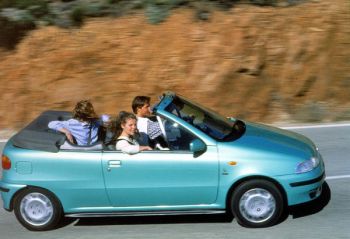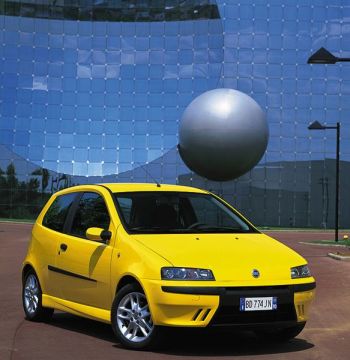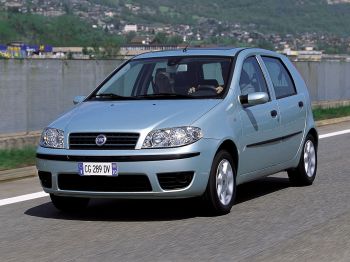|
The 6,000,000th
Fiat Punto model has rolled off the production lines. This
achievement was made possible by the work of the three Fiat
plants where the model is built: the SATA facility in Melfi
near Potenza, Turin’s Mirafiori complex, and the Termini
Imerese factory in the province of Palermo.
The event was celebrated today at Melfi, one of Europe’s
most modern factories, which not only produced the six
millionth Fiat Punto, but also made a decisive contribution
to the accomplishment by turning out half of the total
number of cars.
The Fiat Punto is still the most popular model in Italy, and
has topped the sales charts for over ten years. The first
Punto rolled off the assembly line at Mirafiori in July
1993. Production got under way at Melfi in September of the
same year, and Termini Imerese in December. In 1999, all
three plants began to build the new version of the Punto.
The Melfi plant currently produces both the Fiat Punto and
the Lancia Ypsilon, and employs around five thousand people.
In addition, the SATA facility has been tapped to become the
only site that will construct the future successor to the
Punto, which will continue to be produced at Mirafiori until
the end of 2006.
The Fiat Punto was designed to satisfy every need. The
current line-up, in fact, offers 40 different choices:
three- and five-door versions, eight engine options
(1.2-liter 8-valve, 1.2-liter 16-valve, 1.4-liter 16-valve,
1.8-liter 16-valve, 1.3 Multijet, 1.9 Multijet, 1.9 JTD,
1.2-liter 8-valve gasoline and diesel units); two manual
transmissions with either five or six speeds, the Speedgear
automatic/sequential manual transmission, the Dualogic
transmission that combines automatic and sequential
shifting, and can also be operated as a full automatic in
"Economy" mode; eight trim levels (Actual, Active, Sound,
Dynamic, Class, Emotion, Sporting, and HGT); and 13 body
colors, each available with two different interior outfits.
In addition to this wide range, the Punto is also available
in a van version with three different powerplants (1.2-liter
8-valve, 1.3-liter Multijet and 1.9-liter JTD) and three- or
five-door body styles.
The new owner of the six millionth Punto is Francesco
D’Ariano, resident in Canosa di Puglia near Bari and an
employee at the Melfi plant, who chose a steel grey Dynamic
version with five doors and gasoline engine. The keys to the
car that marked this historic accomplishment were handed
over by Massimo Risi, head of the SATA plant.
FIAT PUNTO: A BRIEF HISTORY
The Fiat Punto was presented in
November 1993 to replace the Uno. Giugiaro designed two
bodystyles for Fiat, a three door and a five door hatchback
(the Cabrio came later), and its fresh design contributed to
it being voted European Car of the Year in 1995. It was also
aerodynamically very efficient, with a drag factor of just
0.31. A completely new car, significant improvements were
made over the old Uno in many areas, in terms of
functionality the much praised class-leading interior space
was one of the most important.
Mechanically the car was really an evolution of the Uno,
with similar solutions being applied to most areas, the one
major new development was the rear suspension, which
followed the independent layout of the Tipo.
In terms of safety, the new Punto featured a structure
designed to meet much more stringent crash tests including
side impact protection, dual front airbags (optional on some
models), various fire protection systems such as a fuel
cut-off valve, anti-submarining seats, seatbelt
pretensioners, energy absorbing steering wheel and of course
ABS (optional on some models).
The engines were basically the same as in other models,
though improved in numerous minor details. These comprised
1108cc FIRE (54bhp), 1242cc FIRE (58bhp with single-point
fuel injection or 73bhp with multi-point fuel injection),
1581cc sohc (88bhp), 1372cc turbo (136bhp) and 1698cc
diesels (71bhp turbocharged and from 1994 57bhp normally
aspirated) units.
Corrosion protection was another area of the new Punto
which saw many steps forward from the Uno. Over 60% (by
weight) of the bodyshell is galvanised, the majority on both
sides, including 90% of the exterior surface. Long and
severe testing was designed to finally change the poor
reputation some Italian cars had in this area. To produce the Punto Fiat built a new, highly automated and fully
integrated factory near Naples in the south of Italy, at
Melfi. With a large number of major suppliers co-located, it
was one of the most efficient car factories in Europe at the
time of its construction. The Punto was also produced in
smaller numbers at Mirafiori and Termini Imerese in Sicily.
Apart from the standard models there was also the
'Selecta', fitted with a CVT, using the 1242cc unit (in this
application with 60bhp) and the Cabrio.
|


 |
|
The first series of the Fiat Punto included a Cabrio
version (top), the second series spawned an
aggressive-looking 1.2-litre 16v 'Sporting' version
(middle), while the final facelifted evolution was
introduced two years ago
(above) |
|
|
 |
|
The owner of the 6,000,000th Punto is Francesco
D’Ariano, resident in Canosa di Puglia near Bari and
an employee at the Melfi plant, who chose a 5-dr
steel grey Dynamic version |
|
 |
|
 |
|
The keys to the 6,000,000th Fiat Punto were handed
over in a ceremony by Massimo Risi, head of the SATA
plant in Melfi |
|
 |
|
|
The Cabrio was
designed by Giugiaro and built by Bertone. Available with
either the 1242cc or 1581cc engine, it featured a reinforced
structure, including an anti-roll bar built into the
windscreen pillars. Shortly after the initial launch, in May 1995, the Punto Sporting was released. This also used the 1581cc unit,
but with lower gearing. Some extra body trim, alloy wheels,
internal trim changes and suspension changes similar to
those used on the GT (1372cc turbo) model were also applied,
the result being a car with heightened driver appeal.
1997 saw the replacement of the 1581cc engine in both the
Sporting and the Cabriolet by a 1242cc 16V FIRE engine with
86bhp. Numerous other changes were made to most models,
including power steering, air conditioning, new interior
trims and external colours, revised suspension settings,
improved soundproofing, new wheels and various detail
modications.
The 'Nuova Punto' was introduced on the 100th
anniversary of the Fiat company in the summer of
1999. Although actually a mid-life update of the old
Punto, most of the car is new (80% of parts are
new), including an all new exterior design and new
rear suspension (torsion beam). Class leading
interior space and passive safety (the car received
an excellent four stars in the Euro NCAP test) were
praised by the press.
Available with three or five doors, and a range
of engines comprising a 1242cc 8V with 60bhp, 1242cc
16V with 80bhp, 1910cc diesel with 60bhp, 1910cc JTD
diesel with 85bhp (previously 80bhp) and at the top,
the 1747cc 16V with 130bhp. This latter unit is the
same as that in the Barchetta and Coupé. A special
mention is deserved by the Sporting, which uses the
1.2 16v engine coupled to a six-speed manual
gearbox. This model also features a stiffer
suspension and an aggressive bodykit, and really
follows the character of sportier small Fiats, being
a genuine 'put a smile on your face car' without
being seriously fast.
The three and five door cars are slightly
differently styled, the five door having a more
aggressive appearance especially from the front. All
cars come with a drivers airbag and options include
passenger and side airbags (standard in some
markets). Other new features are the electronic
power steering (with two levels of assistance
selectable by the driver) and 'follow-me-home'
headlights which stay on for a predetermined time
after you lock the car. The HGT also features as
standard a satellite navigation system, ABS and
traction control. Transmissions include a five speed manual, a six
speed manual and a CVT ('Speedgear'). This latter
can be used in the fully automatic mode, or as a
sequential shift, with either six or seven preset
ratios (depending on model). The Punto proved to be a popular car and its
mass appeal has led it to being the best-selling car
in Europe for some years, whilst in early 2003 the
5,000,000th Punto was produced.
In May 2003 a heavily revised Punto was released,
the third incarnation of the best-selling car.
Significant changes to the appearance were joined by
new engines and content. The whole front
end was new, including the bonnet,
lights, bumper, wings grill etc, whilst at the rear
the bumper changed and some other detail changes
made including the adoption of the round Fiat badge
and additional reflectors on the three door car.
Whereas the previous car had differentiated between
three and five door versions visually (with
different front and rear bumpers), the new car
features a front end which is different for the
sportier versions, the Sound (or Active Sport)
Sporting and HGT, with all the other (both three and
five door) using the same bumpers.
Under the bonnet the same 1.2 8v (60bhp)
and 16v (80bhp) engines together with the 1.8 16v
(130bhp) and 1.9 JTD (85bhp) continue, but they were
joined by three new units. A 1.4-litre development
of the FIRE engine with 95bhp is now available
(fitted to the new Sporting version), and a 1.9 MultiJet JTD
with 100bhp is also offered, derived from the
earlier engine. Completely new was the award
winning 1.3 16v MultiJet with 70bhp, claimed to be
the smallest, most compact diesel, incorporating all
the latest technology such as common-rail, dohc,
16v, EGR-cooling, turbocharging etc.
Other significant additions to the model included
a new transmission known as Dualogic. This is a
Selespeed-like unit, being a manual gearbox
controlled by hydraulic actuators, in turn
controlled via a sequential shift with a
fully-automatic mode available. A dual-zone climate
control was new in the segment and added to the
comfort and ease of use, as did the rain and parking
sensors.
Safety had also been taken care of with
ESP, MSR and various other electronic aids being
added to the various versions, as well as up to six
airbags being available. Novelties included a
"hill-holder" which keeps the brakes on for 2
seconds if the car is in first gear and a sensor
decides that it is on an incline - designed to make
for perfect hill starts every time. New colours, interior trims and various changes
including the instrumentation and wheels complete a
comprehensive makeover for the best-selling Fiat.
This year saw a further
and final revision of the Punto arrive,
affecting only the interiors. Various new interior
trims and colours were introduced, as well as a
couple of new exterior finishes.
|
|
|
|
|
|
![]()
![]()